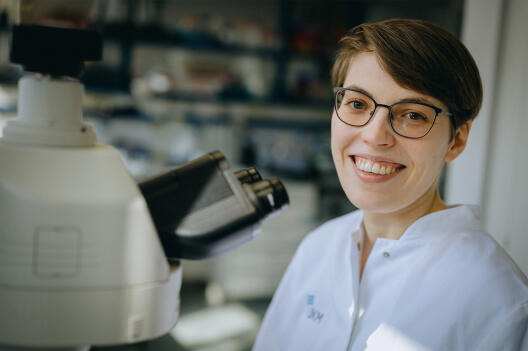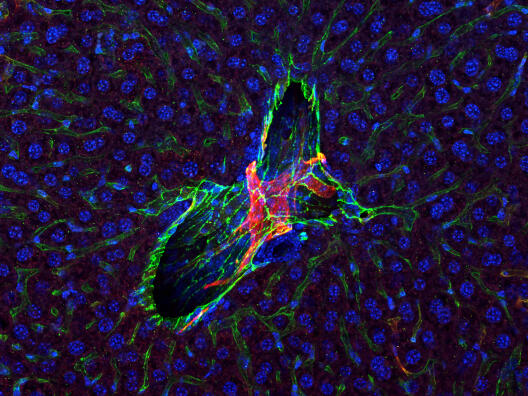First graduate of the Study Programme “Experimental Medicine”

Just in time for her third state examination in human medicine, Stefanie Bobe has completed in parallel her Master of Science in Experimental Medicine at the University of Münster. She is the first graduate of this programme, which introduces future physicians to experimental lab research as a complement to their clinical training. “I wanted to dive deeper into medicine,” the 26-year-old says. In medical school, she adds, the focus is on how certain medical conditions manifest, how they affect people, and how one can help patients. “But I’m also fascinated asking about the underlying mechanisms that build the biomedical basis for improved diagnostic and therapeutic options,” she explains. As a result of her studies, she says, she feels better equipped to ask even more questions and search for their answers using the appropriate methods. Stefanie Bobe was part of the first cohort of 15 students, who in the summer 2015 started the Experimental Medicine programme, which consists of a “Junior class” and a Master’s programme. Currently, 123 students are enrolled in the programme.
Students participate in current research

“During my studies, I spent at least as much time in the lab as in the clinic,” says Stefanie Bobe. In the practical courses, she was trained in the basic skills required for working with cells, gained insights into various research areas and took part in ongoing experiments in different laboratories. In doing so, she met numerous researchers also from biology and chemistry who contribute to educating students at the Faculty of Medicine. “This close connection between medicine and the natural sciences has grown through research at the University of Münster over many years,” says Prof Rupert Hallmann, coordinator of the Study Programme in Experimental Medicine. The interconnection between disciplines is also structurally established through a cross-faculty scientific institution – the Cells in Motion Interfaculty Centre. “This mindset held by our research groups is alive in our teaching, too,” says Rupert Hallmann.
Stefanie Bobe gained a particularly deep insight into experimental research in the team of biochemist Prof Friedemann Kiefer. For her Master’s thesis, she investigated what the lymphatic vessels of the liver look like in mice and established techniques to stain and three-dimensionally visualise them using a light sheet microscope. “I really love looking at microscopic images,” she says with a smile. A subsequent project then focused on similar analyses performed on samples of the human liver and imaging the bile ducts, which can play a role in inflammatory processes and cancer in the liver. For this project, Friedemann Kiefer’s team worked together with surgeon Prof Jan Schulte am Esch and physicist Prof Thomas Huser from Bielefeld University. “I feel super comfortable in this team because, on the one hand, I’m standing in the lab myself working biologically, but I also understand how tissue samples are taken from patients during surgical operation,” Stefanie Bobe says. Utilising different optical imaging techniques, the team succeeded in providing a new description of liver structures of different size dimensions that for the first time seamlessly cover the entire scale from nanoscale to millimetres to centimetres. The project resulted in a publication in a scientific journal, on which Stefanie Bobe is one of the two first authors. The team has now used the new imaging techniques to further investigate the bile ducts and identify starting points for new diagnostics in liver diseases. Further publications are in the pipeline.
“For the extra effort, you get great rewards”
Stefanie Bobe completed most of the study programme in parallel with her medical studies. “That’s a special organisational feature of the Münster programme,” explains Rupert Hallmann. The programme consists of a six-semester long “Junior class” and three semesters in the Master’s programme. “I only had a few weeks off during my studies because I used the semester breaks for the practical courses – but for the extra effort, you get great rewards,” says the medical graduate. She completed her “Junior class” a semester ahead of schedule and worked on her Master’s thesis full-time for a year. One of the practical trainings was part of a semester abroad in Vienna. “Of course, things do not always go according to plan A in a new degree programme,” she says. However, she adds that she experienced this as an opportunity and was allowed to organise the programme modules very flexibly. In the future, Stefanie Bobe wants to remain faithful to her love of microscopy and continue to work with tissue samples. She is planning to do her residency in pathology and hopes to have the possibility to combine her work as a medical doctor with research in this next career step as well.
Links
- Study Programme “Experimental Medicine” for students of human medicine at the University of Münster
- Scientific publication by Stefanie Bobe in the journal “Frontiers in Physiology”: Kong C*, Bobe S*, Pilger C, Lachetta M, Oie CI, Kirschnick N, Monkemoller V, Hubner W, Forster C, Schuttpelz M, Kiefer F, Huser T, Schulte Am Esch J. Multiscale and Multimodal Optical Imaging of the Ultrastructure of Human Liver Biopsies. Front Physiol 2021;12: 637136. (*Authors contributed equally.)
- Research group of Prof Friedemann Kiefer at the University of Münster
Author: Doris Niederhoff

